How to Fix Zoom Audio Problems
How-To
Mục lục
How to Fix Zoom Audio Problems
![]()
By

Can you see friends or colleagues on Zoom, but can’t hear them? Here are some tips on how to fix Zoom audio.
Zoom has grown into one of the biggest video conferencing apps in the world. It allows you to have high-quality voice and video calls one-to-one or with hundreds of people. The app is simple to use— you don’t usually need to delve into any complicated settings.
From time to time, you may find that your Zoom audio isn’t working properly. For example, you may not be able to hear other people on your call, or the sound may appear strange.
If you’re unsure how to fix Zoom audio issues like these, you can follow the troubleshooting steps below.
Check For Muted Participants
If you can’t hear the other people in your Zoom call, it may have nothing to do with your own computer. The other participants might be muted without realizing it.
If they can hear you, ask them to click on the Microphone icon in the menu at the bottom of Zoom until it no longer has a red line through it. If they can’t hear you, you can send a chat message through Zoom to alert them instead.
To send a chat message in Zoom:
- Move your mouse anywhere on the Zoom screen.
- Click Chat in the bottom menu.
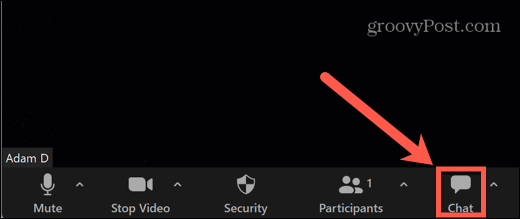
- You can send the message to everyone or click the drop-down to select specific people.

- Type your message at the bottom of the chat window and press Enter to send it.

Check Your Computer Volume
Another reason that you may not be able to hear anyone in your Zoom call is if your computer volume is too low (or muted entirely). Try using the volume buttons on your keyboard to turn the volume up and see if this makes any difference.
If this doesn’t work, you can use the Volume Mixer on Windows 10 and 11 to change the volume for the Zoom app.
To change the Zoom volume in Windows 11:
- Right-click on the Volume icon in the taskbar.

- Select Open Volume Mixer.

- Ensure that both the System Volume and Zoom Volume sliders are set at a high enough level for you to hear the audio.
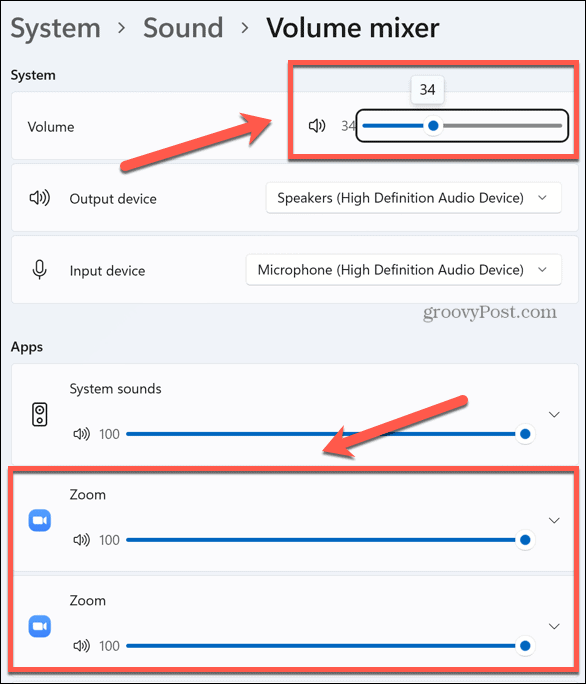
Check Your Speaker or Headphone Connections
If you’re using external speakers or headphones, their connection might be faulty.
For wired speakers or headphones, check that they are plugged in correctly. If they are, try a different port to see if this improves things.
If you use Bluetooth speakers or headphones, ensure that Bluetooth is enabled on your computer and that your speakers or headphones have sufficient charge.
Choose the Correct Audio Output
Zoom allows you to choose which audio output (eg. your headphones or speakers) Zoom audio plays through. If you have the wrong speakers selected, you may not be able to hear anything.
To select the correct speakers or headphones in Zoom:
- Move your mouse anywhere in the Zoom window to bring up the Zoom menu.
- Click the arrow next to the Microphone icon.
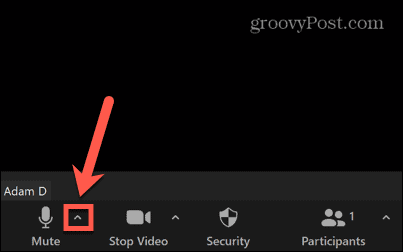
- Choose your speakers under Select a Speaker.
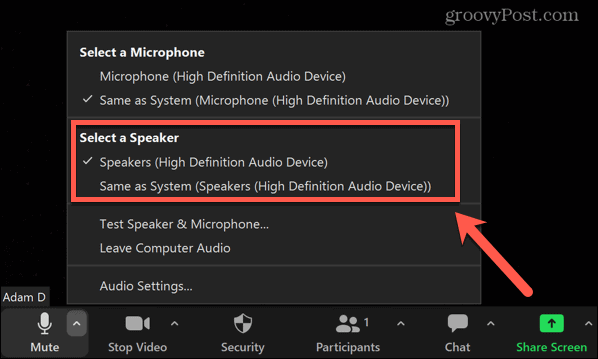
Test Your Speakers
If you think that your speakers may be the cause of your Zoom audio problems, you can test your speakers to make sure they’re working as expected.
To test your speakers in Zoom:
- Move the mouse within the Zoom window to bring up the Zoom menu.
- Click the arrow next to the Microphone icon.

- Select Test Speaker & Microphone.
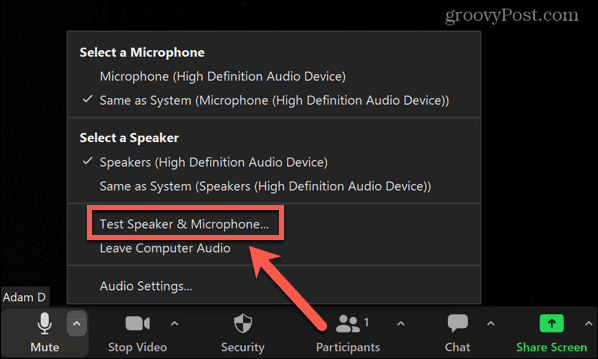
- You will be asked if you can hear a ringtone. If you can, click Yes.
- If you can’t, select No, Try Another Speaker instead.
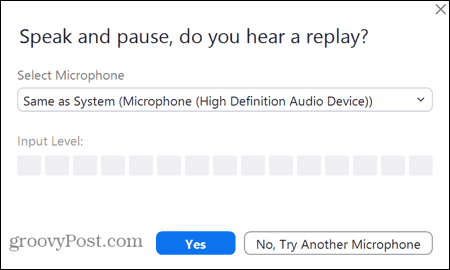
- You will then be asked to speak, and you should hear what you said repeated back to you. If you can, click Yes.
- Otherwise, select No, Try Another Speaker.

- If you can hear audio on both tests, then your speakers are working properly in Zoom. If not, you’ll need to try one of the other fixes in this list.
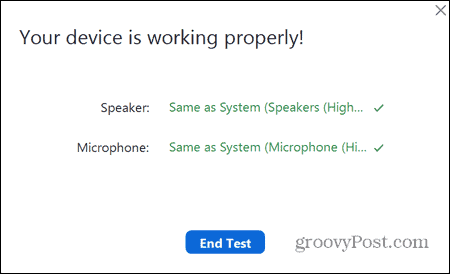
Fix Your Zoom Audio Settings
Zoom will use default settings to run audio and video calls, but you can change these yourself via the Zoom app. You may be able to fix Zoom audio problems by changing some of these default audio settings.
To change audio settings in Zoom:
- Launch Zoom.
- Click the Settings icon in the top-right corner.

- Select Audio from the menu on the left.

- Choose the speaker you want to use by default.
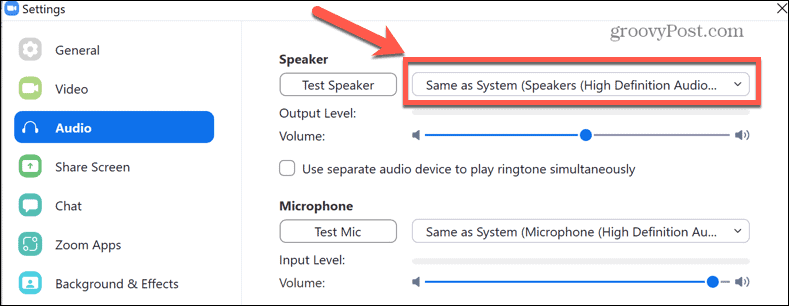
- You can click Test Speaker to ensure the selected speaker is working as expected.
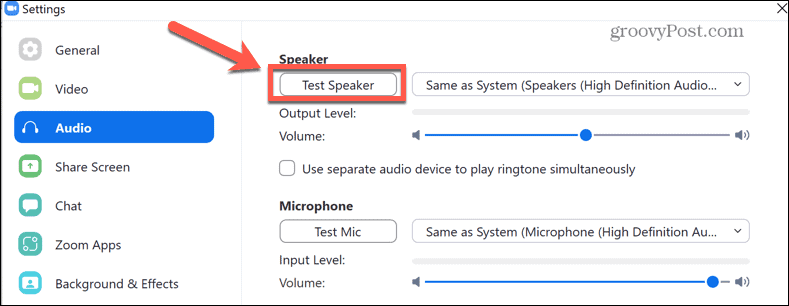
- Scroll down to find the Suppress Background Noise The default setting is Auto—trying a different setting may improve your Zoom audio.
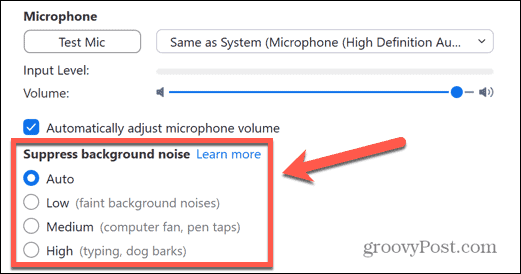
- Just beneath this, try checking Show In-Meeting Option to Enable “Original Sound”. Enabling this in a Zoom call disables noise suppression, high-pass filtering, and gain control. It is recommended for playing music or in audio studio situations, but tweaking these settings may help to fix your Zoom audio problems.

- At the bottom of the screen, you can change the ringtone volume and ringtone.

- Click Advanced.
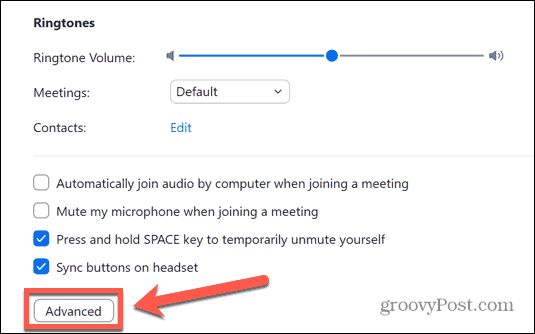
- By default, these advanced settings are set to Auto. If they’re on a different setting, try setting them to Auto and seeing if this fixes your Zoom audio issues.

- If the settings are already set to the default values, try changing them to see if it will fix your Zoom audio.
Check Your Computer Audio Settings
If you’re suffering from Zoom audio problems, you may need to check your computer audio settings. One of these settings may be causing your Zoom audio to function incorrectly.
Configuring Windows 11 Audio Settings
To change audio settings on Windows 11:
- Right-click on the Volume icon.

- Select Sound Settings.
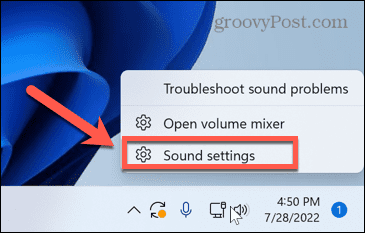
- Scroll through the menu—under Advanced select All Sound Devices.

- Click Speakers.
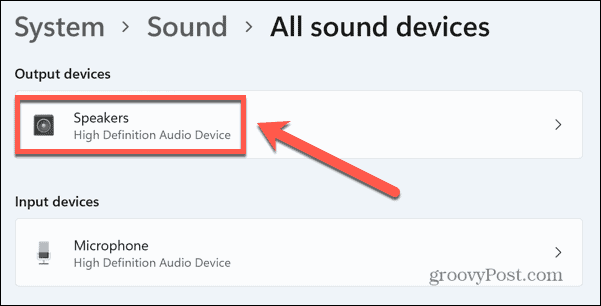
- Click Check for Driver Updates to ensure that your driver is not out of date.

- Ensure that you see Don’t Allow next to the Audio section.
- If this button reads Allow, click it to allow apps and Windows to use your speakers for audio.
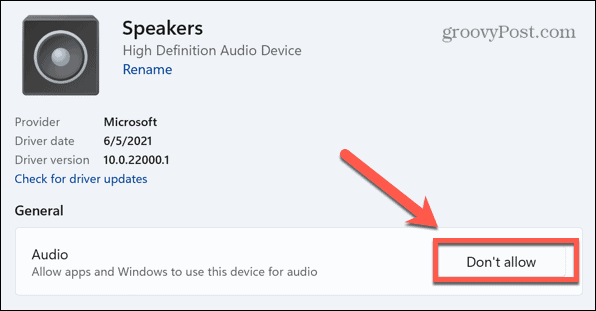
- Scroll down and ensure that the Enhance Audio slider is set to Off.
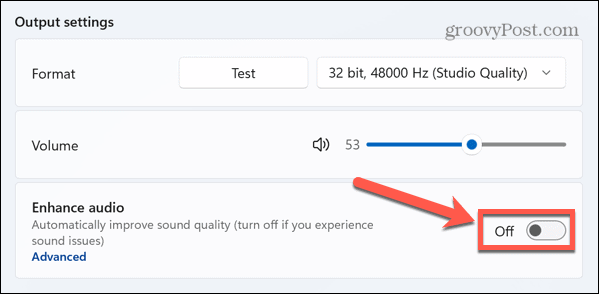
- If you want to change individual audio enhancements, click Advanced.
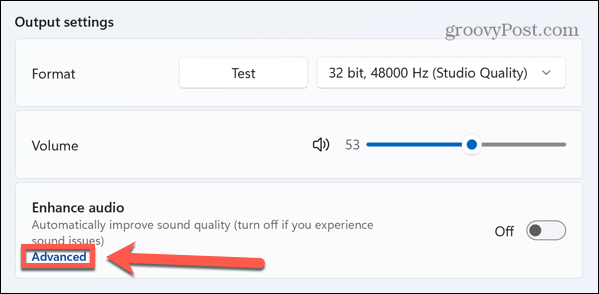
- Disable any audio enhancements that you want to turn off.
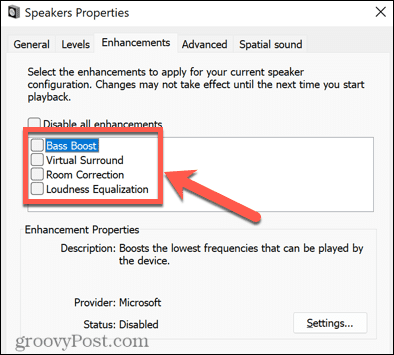
Configuring Mac Audio Settings
You can also configure your audio settings for Zoom on macOS using the System Preferences menu.
To change audio settings on Mac:
- Launch System Preferences.

- Select Sound.
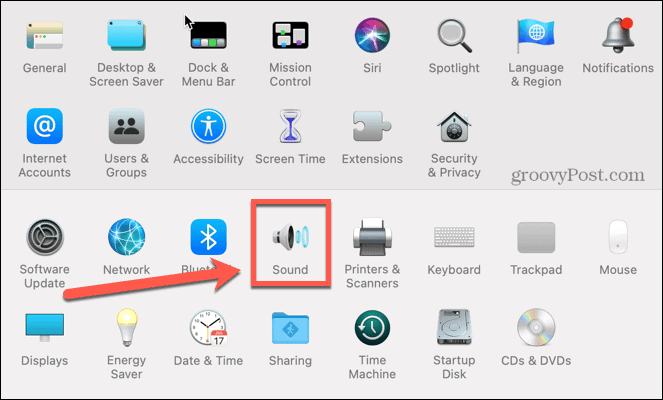
- In the Output tab, select the speakers you want to use.
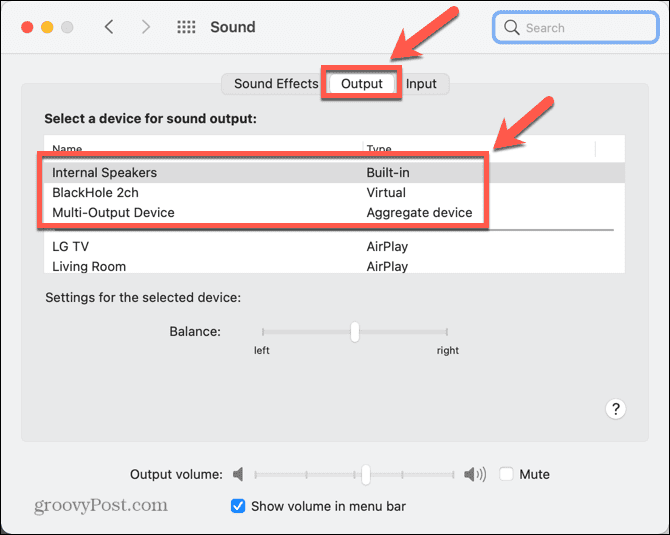
Restart Your Computer
Are you still having trouble with your Zoom audio? The age-old technique of turning your computer off and on again may once again come to the rescue to fix hard-to-diagnose Zoom audio problems.
When you restart your PC or Mac, you’ll clear any running processes. If another app is interfering with your speakers, for instance, this could resolve the problem.
To try this, restart your computer, launch Zoom again, and see if your audio problems improve.
Reinstall Zoom
As a last resort, you can try completely uninstalling your Zoom app and reinstalling it again. This may fix any settings you’ve accidentally changed and can no longer find again. It can also fix things if Zoom’s installation is corrupted in some way.
Reinstall Zoom on Windows 11
To reinstall Zoom on Windows 11:
- Click the Start icon.

- Open the Settings app.

- Select Apps from the left-hand menu.

- Select Apps & Features.
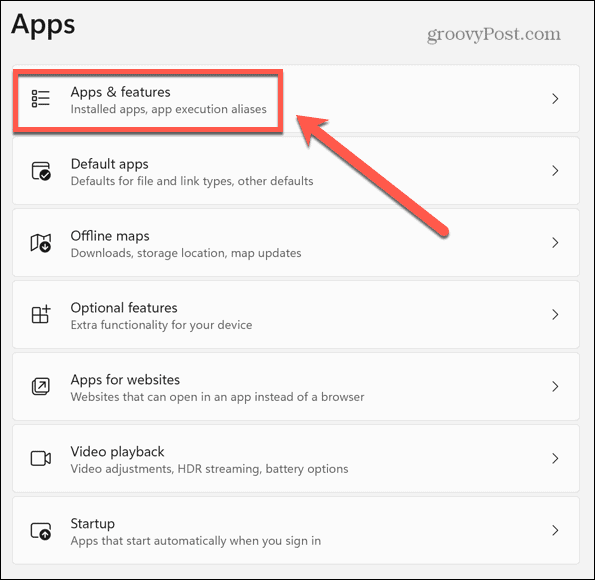
- Scroll down to Zoom and click the three dots icon.

- Click Uninstall.

- Once the process completes, reinstall the Zoom app once more.
Reinstall Zoom on Mac
To reinstall the Zoom app on Mac:
- Launch Zoom.
- In the menu bar, click Zoom.us.

- Select Uninstall Zoom.

- Confirm your decision.

- Once the uninstallation process is complete, reinstall the Zoom app.
Make Room for Zoom
Knowing how to fix Zoom audio allows you to get your video calls back on track so you don’t miss those important meetings. If your Zoom audio isn’t working, one of the fixes above should help to solve your Zoom troubles.
If you can hear the other participants, but they can’t hear you, then you’ll also need to know how to fix Zoom microphone problems. Struggling with your camera? If no one can see you, then there are some steps you can take to try to fix your Zoom camera, too.
Once you’ve fixed everything, you can try out a few Zoom tricks, such as adding custom backgrounds to your Zoom meetings.







